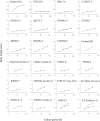A genome-wide survey and systematic RNAi-based characterization of helicase-like genes in Caenorhabditis elegans
- PMID: 17921522
- PMCID: PMC2533593
- DOI: 10.1093/dnares/dsm016
A genome-wide survey and systematic RNAi-based characterization of helicase-like genes in Caenorhabditis elegans
Abstract
Helicase-like proteins play a crucial role in nucleic acid- and chromatin-mediated reactions. In this study, we identified 134 helicase-like proteins in the nematode Caenorhabditis elegans and classified the proteins into 10 known subfamilies and a group of orphan genes on the basis of sequence similarity. We characterized loss-of-function phenotypes in RNA interference (RNAi)-treated animals for helicase family members, using the RNAi feeding method, and found several previously unreported phenotypes. Fifty-one (39.5%) of 129 genes tested showed development- or growth-defect phenotypes, and many of these genes were putative nematode homologs of essential genes in a unicellular eukaryote, budding yeast, suggesting conservation of these essential proteins in both species. Comparative analyses between these species identified evolutionarily diverged nematode proteins as well as conserved family members. Chromosome mapping of the nematode genes revealed 10 pairs of putative duplicated genes and clusters of C. elegans-specific SNF2-like genes and Helitrons. Analyses of transcriptional profile data revealed a predominantly oogenesis- and germline-enriched expression of many helicase-like genes. Finally, we identified the D2005.5(drh-3) gene in an RNAi-based screen for genes involved in resistance to X-ray irradiation. Analysis of DRH-3 will clarify the potentially novel mechanism by which it protects against X-ray-induced damage in C. elegans.
Figures


Similar articles
-
Dicer-related drh-3 gene functions in germ-line development by maintenance of chromosomal integrity in Caenorhabditis elegans.Genes Cells. 2007 Sep;12(9):997-1010. doi: 10.1111/j.1365-2443.2007.01111.x. Genes Cells. 2007. PMID: 17825044
-
Transgene-Assisted Genetic Screen Identifies rsd-6 and Novel Genes as Key Components of Antiviral RNA Interference in Caenorhabditis elegans.J Virol. 2018 Aug 16;92(17):e00416-18. doi: 10.1128/JVI.00416-18. Print 2018 Sep 1. J Virol. 2018. PMID: 29950414 Free PMC article.
-
An RIG-I-Like RNA helicase mediates antiviral RNAi downstream of viral siRNA biogenesis in Caenorhabditis elegans.PLoS Pathog. 2009 Feb;5(2):e1000286. doi: 10.1371/journal.ppat.1000286. Epub 2009 Feb 6. PLoS Pathog. 2009. PMID: 19197349 Free PMC article.
-
Uncover genetic interactions in Caenorhabditis elegans by RNA interference.Biosci Rep. 2005 Oct-Dec;25(5-6):299-307. doi: 10.1007/s10540-005-2892-7. Biosci Rep. 2005. PMID: 16307378 Review.
-
Functional genomic approaches using the nematode Caenorhabditis elegans as a model system.J Biochem Mol Biol. 2004 Jan 31;37(1):107-13. doi: 10.5483/bmbrep.2004.37.1.107. J Biochem Mol Biol. 2004. PMID: 14761308 Review.
Cited by
-
The Helitron family classification using SVM based on Fourier transform features applied on an unbalanced dataset.Med Biol Eng Comput. 2019 Oct;57(10):2289-2304. doi: 10.1007/s11517-019-02027-5. Epub 2019 Aug 17. Med Biol Eng Comput. 2019. PMID: 31422557
-
Purification and Characterization of Double-Stranded Nucleic Acid-Dependent ATPase Activities of Tagged Dicer-Related Helicase 1 and its Short Isoform in Caenorhabditis elegans.Genes (Basel). 2020 Jul 1;11(7):734. doi: 10.3390/genes11070734. Genes (Basel). 2020. PMID: 32630243 Free PMC article.
-
Deep insights into Dictyocaulus viviparus transcriptomes provides unique prospects for new drug targets and disease intervention.Biotechnol Adv. 2011 May-Jun;29(3):261-71. doi: 10.1016/j.biotechadv.2010.11.005. Epub 2010 Dec 22. Biotechnol Adv. 2011. PMID: 21182926 Free PMC article. Review.
-
Regulation of heterochromatin assembly on unpaired chromosomes during Caenorhabditis elegans meiosis by components of a small RNA-mediated pathway.PLoS Genet. 2009 Aug;5(8):e1000624. doi: 10.1371/journal.pgen.1000624. Epub 2009 Aug 28. PLoS Genet. 2009. PMID: 19714217 Free PMC article.
-
The DEAD-box protein MEL-46 is required in the germ line of the nematode Caenorhabditis elegans.BMC Dev Biol. 2009 Jun 17;9:35. doi: 10.1186/1471-213X-9-35. BMC Dev Biol. 2009. PMID: 19534797 Free PMC article.
References
-
- Tuteja N., Tuteja R. Unraveling DNA helicases. Motif, structure, mechanism and function. Eur. J. Biochem. 2004;271:1849–1863. - PubMed
-
- Tanner N. K., Linder P. DExD/H box RNA helicases: from generic motors to specific dissociation functions. Mol. Cell. 2001;8:251–262. - PubMed
-
- Cordin O., Banroques J., Tanner N. K., Linder P. The DEAD-box protein family of RNA helicases. Gene. 2006;367:17–37. - PubMed
-
- Lusser A., Kadonaga J. T. Chromatin remodeling by ATP-dependent molecular machines. BioEssays. 2003;25:1192–1200. - PubMed
Publication types
MeSH terms
Substances
LinkOut - more resources
Full Text Sources
Other Literature Sources

